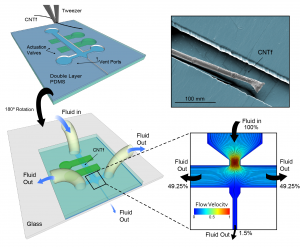 Fascinating research out of the Robinson, Kemere and Pasquali labs in Electrical & Computer Engineering and Chemistry Departments at Rice University, at Baylor College of Medicine and out of the Royer-Carfagni lab in Engineering at the University of Parma. It was published recently in ACS NanoLetters and summarised in NewsMedical, and is focussed on the gentle introduction of microelectrodes for medical applications using microfluidics. The team showed the insertion of carbon nanotube (CNT) electrodes into brain tissue surrogate (agarose gel) as well as rat brains, with subsequent observation of neural activity via these electrodes. The ~30 µm CNT fibre is placed along the central channel in a glass/PDMS microfluidic device, and then carefully controlled sheath fluid flow is used to pull the wire down through a narrower ~100 µm-wide channel and into the tissue. See impressive video showing microfluidic injection of CNT electrode into gel.
Fascinating research out of the Robinson, Kemere and Pasquali labs in Electrical & Computer Engineering and Chemistry Departments at Rice University, at Baylor College of Medicine and out of the Royer-Carfagni lab in Engineering at the University of Parma. It was published recently in ACS NanoLetters and summarised in NewsMedical, and is focussed on the gentle introduction of microelectrodes for medical applications using microfluidics. The team showed the insertion of carbon nanotube (CNT) electrodes into brain tissue surrogate (agarose gel) as well as rat brains, with subsequent observation of neural activity via these electrodes. The ~30 µm CNT fibre is placed along the central channel in a glass/PDMS microfluidic device, and then carefully controlled sheath fluid flow is used to pull the wire down through a narrower ~100 µm-wide channel and into the tissue. See impressive video showing microfluidic injection of CNT electrode into gel.
This technology is an excellent example of marrying microfluidics with nanotechnology, in this case for a medical application. The microfluidic insertion of CNT electrodes in lieu of traditional approaches makes the process less damaging to surrounding brain tissue during insertion. Neuro-sensing applications where gently introduced flexible CNT electrodes would be beneficial may include monitoring for epilepsy, repairing/patching connections for sight and hearing, as well as other areas of neuroscience research.
